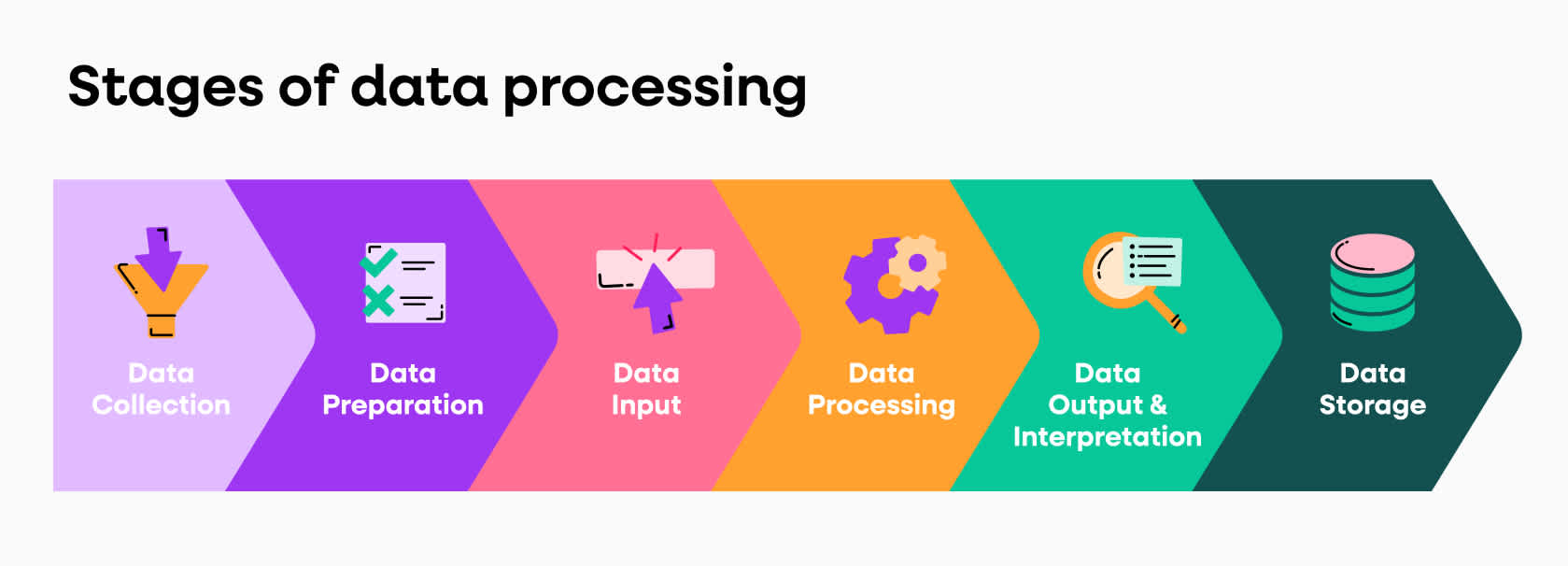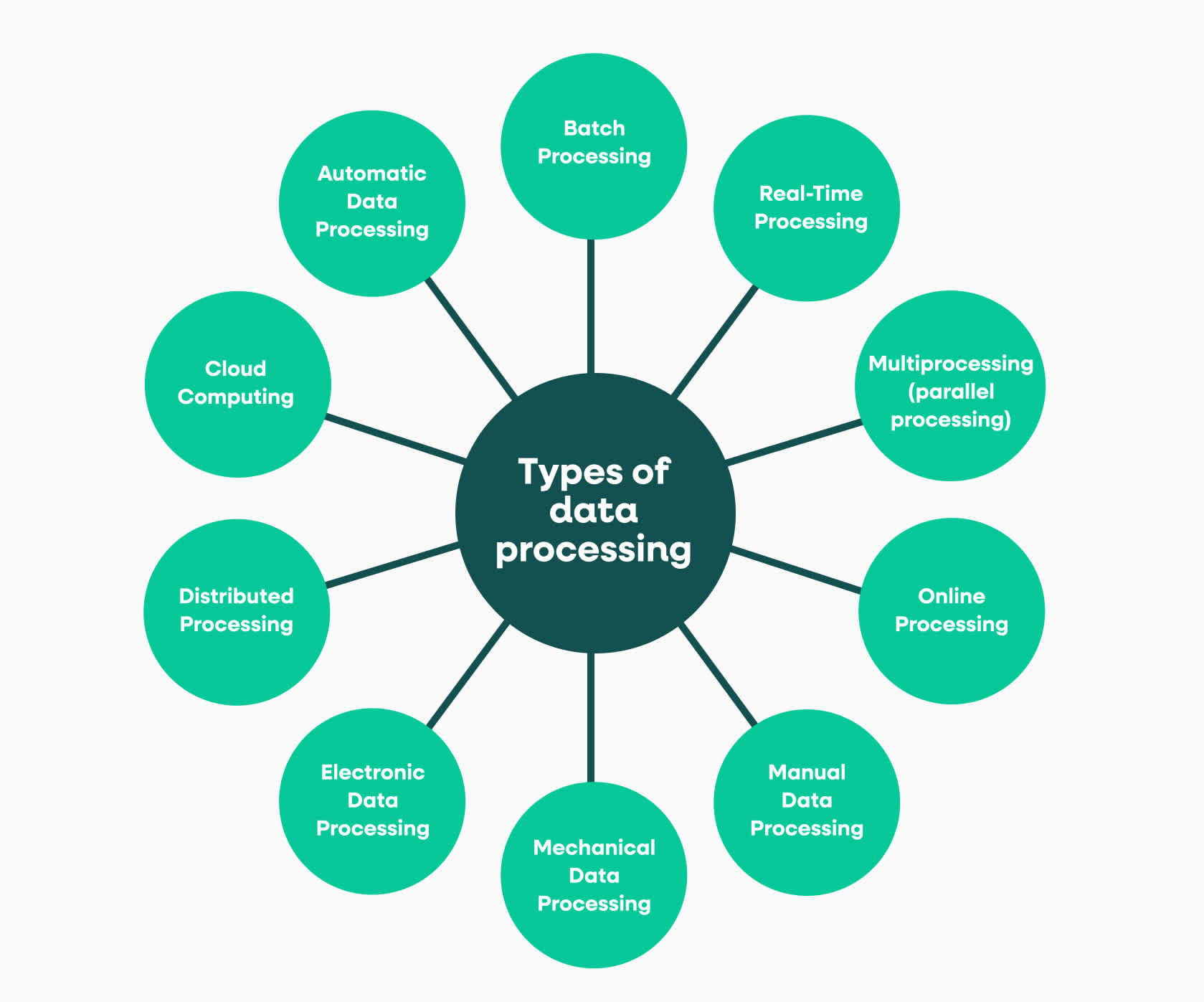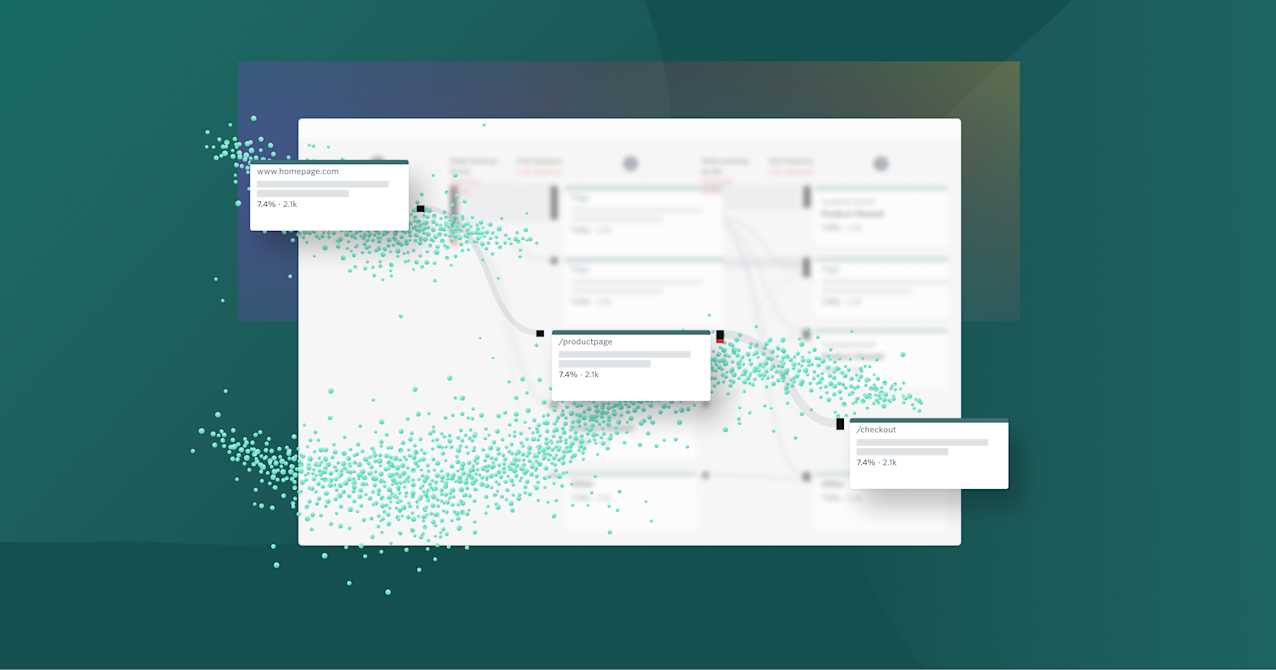So you've been hearing a lot about data processing but still don't quite understand it? We're here to help.
Imagine data processing as akin to a chef preparing ingredients for a meal. Just like a chef carefully selects, chops, and combines raw ingredients to create a delicious dish, data processing involves the careful selection, organization, and transformation of raw data into insightful, useful information.
It's about turning the unstructured and raw into something valuable and meaningful, much like cooking turns basic ingredients into culinary masterpieces.
Key takeaways:
Data processing involves transforming raw data into useful information
Stages of data processing include collection, filtering, sorting, and analysis
Data processing relies on various tools and techniques to ensure accurate, valuable output
What is data processing?
Data processing is the series of operations performed on data to transform, analyze, and organize it into a useful format for further use.
Various stages and methods are used to manipulate raw data into relevant or consumable formats. These stages often include collecting, filtering, sorting, and analyzing the data.
The goal is to extract pertinent information that can be applied in decision-making processes or support existing technologies. To achieve this, data engineers and data scientists employ a range of data processing tools and techniques, ensuring that the output is both accurate and valuable.
Let's dive deeper into each stage.
6 steps in data processing

1. Data collection
The first stage of data collection involves gathering and discovering raw data from various sources, such as sensors, databases, or customer surveys. It is essential to ensure the collected data is accurate, complete, and relevant to the analysis or processing goals. Care must be taken to avoid selection bias, where the method of collecting data inadvertently favors certain outcomes or groups, potentially skewing results and leading to inaccurate conclusions.
2. Data preparation
Once the data is collected, it moves to the data preparation stage. Here, the raw data is cleaned up, organized, and often enriched for further processing. This stage involves checking for errors, removing any bad data (redundant, incomplete, or incorrect), and enhancing the dataset with additional relevant information from external sources, a process known as data enrichment. Data preparation aims to create high-quality, reliable, and comprehensive data for subsequent processing steps.
3. Data input
The next stage is data input. In this stage, the clean and prepped data is fed into a processing system, which could be software or an algorithm designed for specific data types or analysis goals. Various methods, such as manual entry, data import from external sources, or automatic data capture, can be used to input data into the processing system.
4. Data processing
In the data processing stage, the input data is transformed, analyzed, and organized to produce relevant information. Several data processing techniques, like filtering, sorting, aggregation, or classification, may be employed to process the data. The choice of methods depends on the desired outcome or insights from the data.
5. Data output and interpretation
The data output and interpretation stage deals with presenting the processed data in an easily digestible format. This could involve generating reports, graphs, or visualizations that simplify complex data patterns and help with decision-making. Furthermore, the output data should be interpreted and analyzed to extract valuable insights and knowledge.
6. Data storage
Finally, in the data storage stage, the processed information is securely stored in databases or data warehouses for future retrieval, analysis, or use. Proper storage ensures data longevity, availability, and accessibility while maintaining data privacy and security.
Want to find out where your company stands with behavioral data? Download the Fullstory Data Maturity Matrix and take our quiz to find out.
Types of data processing
Data processing utilizes various methods to convert raw data into meaningful information. These methods can be classified into several types, each catering to different scenarios and requirements.
In this section, we will briefly discuss the following data processing types: batch processing, real-time processing, multiprocessing, online processing, manual, mechanical, electronic, distributed, cloud computing, and automatic data processing.

Batch processing
Batch processing involves handling large volumes of data collectively at predetermined times, making it ideal for non-time-sensitive tasks. This method allows organizations to efficiently manage data by aggregating it and processing it during off-peak hours to minimize the impact on daily operations.
Example: Financial institutions batch process checks and transactions overnight, updating account balances in one comprehensive sweep to ensure accuracy and efficiency.
Real-time processing
Real-time processing is essential for tasks that require immediate handling of data upon receipt, providing instant processing and feedback. This type of processing is crucial for applications where delays cannot be tolerated, ensuring timely decisions and responses.
Example: GPS navigation systems rely on real-time processing to offer turn-by-turn directions, adjusting routes based on live traffic and road conditions to ensure the fastest path.
Multiprocessing (parallel processing)
Multiprocessing, or parallel processing, involves utilizing multiple processing units or CPUs to handle various tasks simultaneously. This approach allows for more efficient data processing, particularly for complex computations that can be broken down into smaller, concurrent tasks, thereby speeding up overall processing time.
Example: Movie production often utilizes multiprocessing for rendering complex 3D animations. By distributing the rendering across multiple computers, the overall project's completion time is significantly reduced, leading to faster production cycles and improved visual quality.
Online processing
Online processing facilitates the interactive processing of data over a network, with continuous input and output for instant responses. It enables systems to handle user requests immediately, making it an essential component of e-commerce and online services.
Example: Online banking systems utilize online processing for real-time financial transactions, allowing users to transfer funds, pay bills, and check account balances with immediate updates.
Manual data processing
Manual data processing requires human intervention for the input, processing, and output of data, typically without the aid of electronic devices. This labor-intensive method is prone to errors but was common before the advent of computerized systems.
Example: Before the widespread use of computers, libraries cataloged books manually, requiring librarians to carefully record each book's details by hand for inventory and retrieval purposes.
Mechanical data processing
Mechanical data processing uses machines or equipment to manage and process data tasks, a prevalent method before the digital era. This approach involved using tangible, mechanical devices to input, process, and output data.
Example: Voting in the early 20th century often involved mechanical lever machines, where votes were tallied by pulling levers for each choice, simplifying vote counting and reducing the potential for errors.
Electronic data processing
Electronic data processing employs computers and digital technology to process, store, and communicate data with efficiency and accuracy. This modern approach to data handling allows for rapid processing speeds, vast storage capabilities, and easy data retrieval.
Example: Retailers use electronic data processing at checkouts, where barcode scans instantly update inventory systems and process sales, enhancing checkout speed and inventory management.
Distributed processing
Distributed processing involves spreading computational tasks across multiple computers or devices to improve processing speed and reliability. This method leverages the collective power of various systems to handle large-scale processing tasks more efficiently than could be achieved with a single computer.
Example: Video streaming services use distributed processing to deliver content efficiently. By storing videos on multiple servers, they ensure smooth playback and quick access for users worldwide.
Cloud computing
Cloud computing offers computing resources, such as servers, storage, and databases, over the internet, providing flexibility and scalability. This model enables users to access and utilize computing resources as needed, without the burden of maintaining physical infrastructure.
Example: Small businesses leverage cloud computing for data storage and software services, avoiding the need for significant upfront hardware investments and allowing easy scaling as the business grows.
Automatic data processing
Automatic data processing uses software to automate routine tasks, reducing the need for manual input and increasing operational efficiency. This method streamlines repetitive processes, minimizes human error, and frees up personnel for more strategic tasks.
Example: Automated billing systems in telecommunications automatically calculate and send out monthly charges to customers, streamlining billing operations and reducing errors.
Data processing technologies & tools
Several emerging technologies and tools play vital roles in extracting valuable insights from raw data. This section covers three aspects: Databases and Data Warehouses, Artificial Intelligence & Machine Learning, and Cloud Technology & Data Analytics Platforms.
Databases and data warehouses
Databases are essential in storing structured data, providing the foundation for data processing tasks. They enable efficient querying, updating, and retrieval of information. Examples of popular databases include SQL-based systems like MySQL, PostgreSQL, and Microsoft SQL Server.
On the other hand, data warehouses are large-scale storage systems that accumulate data from various sources. They are optimized for querying and analyzing vast datasets to support business intelligence and decision-making. These warehouses often employ big data technologies such as Hadoop, Apache Spark, and data lakes, providing a centralized repository for massive amounts of data.
Artificial intelligence & machine learning
As the backbone of many modern data processing methods, artificial intelligence (AI) and machine learning (ML) help organizations uncover patterns and make predictions based on available data. Popular ML languages include Python, R, and SAS, offering flexibility and a wide range of libraries for the data processing workflows.
Some of the most impactful ML techniques in data processing are:
Supervised learning: Training models with labeled data to make predictions
Unsupervised learning: Extracting patterns from unlabeled data, such as clustering or dimensionality reduction
Reinforcement learning: Improving actions on-the-fly based on feedback from the environment
These ML approaches have facilitated breakthroughs in diverse fields, from speech recognition to medical diagnostics.
Cloud technology & data analytics platforms
Cloud technology has revolutionized the way businesses handle data processing, offering scalable, cost-effective, and location-independent solutions. Some of the highest-ranked cloud providers include Amazon Web Services, Microsoft Azure, and Google Cloud Platform. These services enable organizations to deploy data analytics platforms and infrastructure without the need to maintain on-premise hardware.
Cloud-based data analytics platforms offer tools and frameworks for ingesting, processing, and visualizing data. Typical components of these platforms include:
Data storage: Storing data in data lakes or other distributed storage systems
Data processing: Running large-scale data operations like ETL workflows and analytics jobs
Data orchestration: Coordinating data processing tasks across different systems and tools
Data visualization: Presenting processed data in an easily digestible manner for decision-makers
Applications of data processing
Business intelligence & strategies
Data processing plays a crucial role in business intelligence and strategies, as it helps organizations transform raw data into usable information. This information is then used for data analysis, visualization, and reporting, which ultimately drive the decision-making processes. For instance, companies use insights derived from processed data to identify trends and growth opportunities and enhance their competitive edge in the market.
Moreover, data processing ensures legal compliance, such as adhering to GDPR regulations, by filtering and securely storing valuable data.
Healthcare, e-commerce, and finance
In healthcare, data processing is employed to analyze electronic health records, monitor patients' health conditions, and optimize treatment plans. For instance, healthcare providers can utilize data analysis to predict and manage disease outbreaks more effectively.
E-commerce platforms leverage data processing to analyze customers' shopping patterns, personalize the shopping experience, and streamline supply chain management. Online retailers can optimize their pricing strategies and enhance customer satisfaction by analyzing and understanding user data.
Finance is another industry that extensively harnesses data processing. Stock trading software employs processed data to generate accurate reports, forecast market trends, and facilitate well-informed investment decisions.
Social media & customer relationship management
Data processing is indeed indispensable in social media and customer relationship management (CRM). Popular platforms such as Facebook and Twitter rely on data processing to curate and personalize content for users, while analysis of user behavior and interactions allows for targeted marketing campaigns.
Data processing enables businesses to segment their customers, track their preferences and interactions, and tailor their marketing efforts accordingly. Furthermore, CRM tools with advanced data processing capabilities can provide real-time insights that help companies improve customer retention and growth.
Convert raw data into action with data processing
Data processing is the key to unlocking the potential of raw data, transforming it into the knowledge that shapes our future. By systematically analyzing and interpreting data, organizations gain critical insights that inform strategic decisions, streamline processes, and drive innovation.
As the volume and complexity of data continue to expand, the ability to understand and effectively process it will become even more essential for success in a data-driven world.



